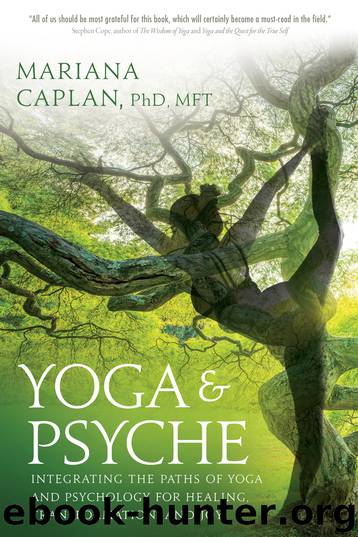Yoga & Psyche by Mariana Caplan

Author:Mariana Caplan
Language: eng
Format: epub, mobi
Publisher: Sounds True
THE TANTRIC PERSPECTIVE: A GOLDEN LINK
“One reaches heaven by the very things which may lead to hell,” says an ancient tantric text called the Kularnava Tantra. The tantric perspective connects the fields of somatics and yoga like a golden link. Unfortunately, what we in the West think of when we hear the word tantra is often limited to esoteric, mystical sex. True, tantra includes sexuality, but the tantric path views all of life as fertile grounds for integrated spiritual transformation. Translated as “continuity,” “fabric,” “to weave,” “technique,” “method,” and “nonrejection,” tantra teaches us to knit the totality of our experience—good and bad, dark and light, spiritual and unspiritual—into one continuous fabric of awakened awareness.
Tantra is most overtly found in Hinduism and Buddhism, but tantric principles can also be found in Jewish Kabbalah, mystical Christianity, Sufism, some martial arts, and certain approaches to somatics and psychology. These approaches share a recognition that spiritual transformation lies within the everyday stuff of life. Rather than attempting to transcend and rise above our human experience, tantra encourages us to move in and through life. Although we may naturally prefer pleasant, blissful, and expansive experiences—and those on a yogic path are often more prone to prioritizing these over others—the tantric perspective encourages us to look at all of life as a transformational theater.
I recall a conversation I had with Robert Beer, a dear friend who is an amazing artist and foremost scholar of Tibetan and Nepali thangka paintings. Thangkas frequently depict Hindu and Buddhist deities and are often used in tantric visualization practices. I had been collecting paintings for some time, and due to my lifelong interest in examining the shadow sides of the psyche, I was particularly interested in the so-called wrathful deities that are fiercely depicted with multiple arms, heads, weapons, and so forth. I asked Robert whether he thought my inclination toward these darker expressions of divinity was problematic. He paused before answering. With a quizzical look, Robert replied, “Dark? Light? These are all expressions of the divine. There is nothing that is not divinity.”
The tantric perspective excludes nothing from the domain of transformation. It values immanence—in this world—as well as transcendence. Tantra even suggests that the exploration of one enhances the discovery of the other. It advocates that enlightenment is not found just by moving toward the light, or by even mindfully observing the dark, but by moving toward and through obscurations as a way of opening to awareness and light. Those of us familiar with asana practice do this when we bring our breath, attention, and curious awareness to the contracted sensations, emotions, and energies in our bodies. By allowing them to simply be there, our acceptance releases tensions and may even open us up to welcome experiences of pleasure, energy, and spaciousness.
Mother Teresa of Calcutta said, “If I ever become a saint—I will surely be one of ‘darkness.’ I will continually be absent from heaven—to light the light of those in darkness on earth.”11 The tantric path of transformation
Download
This site does not store any files on its server. We only index and link to content provided by other sites. Please contact the content providers to delete copyright contents if any and email us, we'll remove relevant links or contents immediately.
Rewire Your Anxious Brain by Catherine M. Pittman(18303)
Talking to Strangers by Malcolm Gladwell(12875)
The Art of Thinking Clearly by Rolf Dobelli(9916)
Mindhunter: Inside the FBI's Elite Serial Crime Unit by John E. Douglas & Mark Olshaker(8702)
Becoming Supernatural by Dr. Joe Dispenza(7836)
Change Your Questions, Change Your Life by Marilee Adams(7377)
The Road Less Traveled by M. Scott Peck(7279)
Nudge - Improving Decisions about Health, Wealth, and Happiness by Thaler Sunstein(7244)
The Lost Art of Listening by Michael P. Nichols(7160)
Mastermind: How to Think Like Sherlock Holmes by Maria Konnikova(6937)
Enlightenment Now: The Case for Reason, Science, Humanism, and Progress by Steven Pinker(6875)
Win Bigly by Scott Adams(6828)
The Way of Zen by Alan W. Watts(6289)
Daring Greatly by Brene Brown(6227)
Big Magic: Creative Living Beyond Fear by Elizabeth Gilbert(5354)
Grit by Angela Duckworth(5301)
Men In Love by Nancy Friday(4964)
Ego Is the Enemy by Ryan Holiday(4958)
Altered Sensations by David Pantalony(4867)
